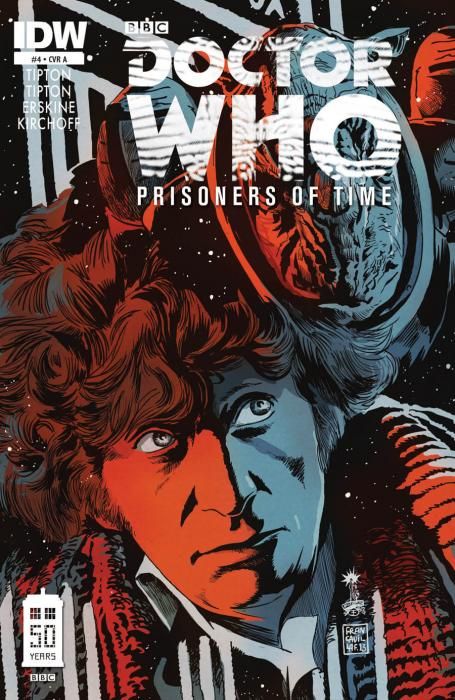The concept behind the "Doctor Who: Prisoners of Time" mini-series -- each issue focusing on a different Doctor and set of companions, which will eventually lead into a big climax for issue #12 -- is a fun one, and Scott and David Tipton deserve credit for that idea. But four issues into the series, there's a strong sameness in each installment, and with that a certain level of unevenness.
The visuals courtesy of Gary Erskine (with help from Mike Collins) are definitely not the problem. Erskine's able to keep his own art style without also losing the familiar looks of Tom Baker and Louise Jameson playing the 4th Doctor and Leela. Erskine goes back to the well of Baker's toothy grin a great deal, but to his credit it doesn't ever come across as stiff or posed. He and Leela both come across animated and entertaining to watch, and their expressions are by far the best part of their depiction. They do occasionally come across a bit oddly, though; Leela leaping into the Judoon ship looks just bizarre, for instance, and a page later it feels like Leela's leg has just been eaten by speed lines.
The new aliens in "Doctor Who: Prisoners of Time" #4 also fit the 1970s era of the 4th Doctor stories well; with matching uniforms and different colored skin, you can see them stepping out of almost any story from that time period. It's a little odd to see them next to the modern-series creation of the Judoon, though; they don't really fit the rest of the story either tonally or visually, making their inclusion a head-scratcher. Erskine tries to make them work, but I'd have rather seen the Tiptons just create a new police group instead of adding in a creation that doesn't hit for another 30 years.
The story from the Tiptons is ultimately the uneven part of this comic. The early portions work well enough; it's very relaxed and I can see it fitting into Season 15 well enough. The Doctor's in his aimless wandering mode, which works well with the time period, and Leela and K-9 have hit the point where the two play off each other well as noble savage versus robotic dog. It's a little odd, though, to have a mini-series where one of the main thrusts is how important the companions are to the Doctor and then give them almost no interaction with one another. Leela and K-9 are sent off to form a distraction while new characters accompany the Doctor to the climax of the story, which feels a little wrong-headed. And even if you ignore the whole "companions are important" part that's supposed to thread through all of "Doctor Who: Prisoners of Time," it's hard to ignore that Leela and K-9's side adventure is pure filler. I'd go so far as to say their entire presence could have been deleted and the story itself wouldn't have changed. That's not a good sign at all.
I'm pretty sure the underlying conclusion of "Doctor Who: Prisoners of Time" #4 wasn't supposed to be, "Companions, eh, who needs them?" but that's where the wheels are falling off a bit. Once again, I want to like this comic more than I actually do. The visuals are pretty fun (and Francesco Francavilla's covers have been outstanding) but there needs to be some real script tightening in this series, and soon.

